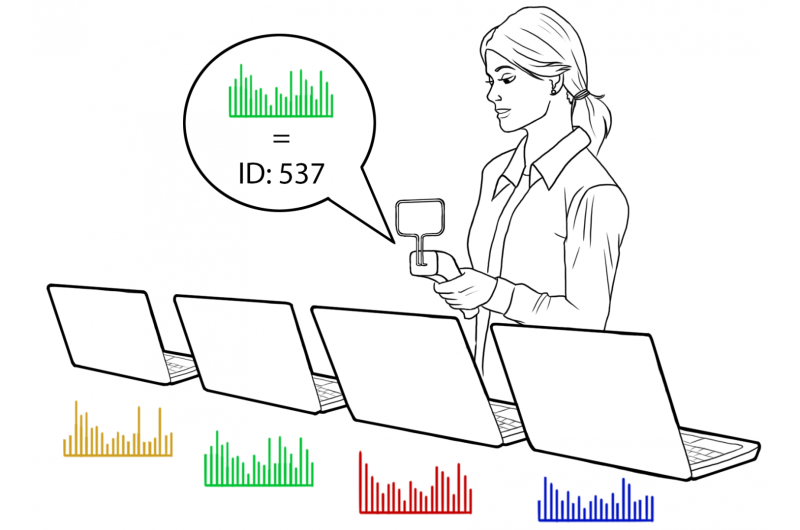Like a fingerprint, system noise can be used to differentiate identical electronic devices

Radio frequency emission are considered incidental system noise in virtually all laptops, smartphones and other electronic devices, but scientists at Disney Research have found a way to use these spurious electromagnetic (EM) signals to uniquely identify even seemingly identical devices.
Their method, called EM-ID, can differentiate in most cases between devices of the same make and model.
"The idea that these electronic devices have such distinctive RF emissions is astounding," said Jessica Hodgins, vice president at Disney Research. "Our researchers were able not only to discover this phenomenon, but to develop a means of using it to identify devices right out of the box."
Disney Research's Chouchang Yang and Alanson P. Sample will present the method May 3 at the IEEE International Conference on RFID 2016 in Orlando, Fla.
Previous research by Yang, Sample and others has shown that the electromagnetic (EM) noise emitted by most electronic devices is distinctive enough that it can be used to distinguish between general classes of objects - power tools, computers, household appliances, automobiles and more. The new research by Yang and Sample shows that it's even possible to use these spurious EM signals to differentiate between objects of the same make and model.
"Electromagnetic emissions are highly structured and a direct manifestation of the circuits that generate them," Yang said. "But variations in the manufacturing of all components and in final assembly create differences in the EM signal that enable us to differentiate, for example, a laptop computer from another laptop of the same make and model."
"It's not foolproof," said Sample, leader of Disney Research's Wireless Systems group. "Since the EM signature of a given device is an emergent statistical property and not designed to be a unique ID, it is possible that the EM spectrums may overlap, making it hard to identify some objects."
In testing, the researchers found that they could successfully identify individual devices with 95 percent accuracy - ranging from 72 percent accuracy for the iPhone 6 to 100 percent accuracy for toy light sabers.
"But even though we can't ensure that EM-IDs are always unique, we have a reliable algorithm for predicting the identification success rate," Sample said. "So when a new device is registered and entered into an inventory system, it can alert the user whether the device's EM-ID is unique enough to be read or if an alternative strategy is needed."
Another limitation is that the device must be powered on and actively emitting the EM signals for the identification method to work.
The EM-ID system uses a low-cost software-defined radio as a reader. The EM signals are digitized and sent to a host computer, where the signals are processed to remove low-magnitude EM noise, leaving a number of frequency peaks that typically include between 1,000 and 2,000 elements.
Because of perturbations that can occur in the device's EM-ID from one reading to the next and variations in the signal sensitivity of different EM readers, Yang and Sample developed a two-stage ranking process for identifying a unique device. In the first stage, the frequency distribution of the unknown device is compared with those of different categories of devices. Once the device is classified - say, that it is an iPhone 6 - it is then differentiated from other iPhone 6 devices, a much more challenging task. Because the frequency distributions tend to overlap within a class, both the frequency and magnitude are taken into consideration at this stage.
"The signal processing and mathematical framework we've established lays the foundation for using electromagnetic emissions for identification purposes," Sample said.
More information: "EM-ID- Tag-less Identification of Electrical Devices via Electromagnetic Emissions-Paper" [PDF, 2.82 MB]
Provided by Disney Research



















